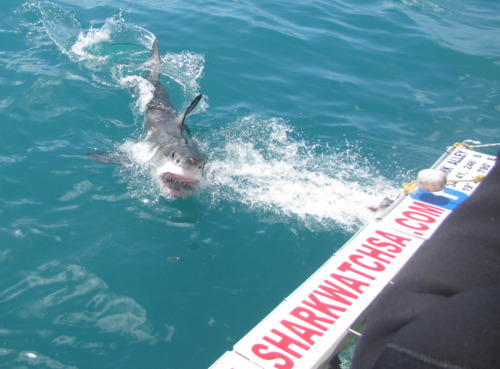
Above: Check out the teeth on this guy.
Cage diving was always been something I was going to do in South Africa. It would be on my bucket list I guess, if I knew exactly what that term meant. The only issue was that I wanted to find a responsible tour operator, not a gung ho cowboy who throws a couple of goat carcasses into the ocean and waits for the sharks to come, disregarding any environmental or ecological concerns. And it begs the question, who wants be in a small cage surrounded by great whites in a feeding frenzy anyway? A bit of research (thanks to the wife) and we found an operator whose environmental credentials I was happy with.
We were diving out of Gansbaai, which has assumed the mantle of the cage diving capital of South Africa and is the best place on Earth for tourists to see great whites. Gansbaai is a small town three hours or so from Cape Town and is like any other small town from around the world in that when it finds something to embrace, it doesn’t let go. The association Gansbbai has with sharks is a long running one, although initially it was through a shark liver oil factory in the 1940s. Now, the emphasis is very much focused on live sharks and reminders of sharks are omnipresent here in this town of 7000. At the Great White House, (the home of our tour operator), a quick video and a Q&A session sufficed for our training and we soon boarded the boat to find ourselves some great whites. Sharing Jaws quotes, the passengers were excited but subdued. For some, this may have been conquering a fear or phobia, for others something to fill in a holiday, for others offering a chance to do something they had been wanting to do for a long time. Whatever the motivation, everyone was tense, hopeful that today wasn’t going to be one of those rare days were no or few sharks are spotted on the dive. Since it was summer, we didn’t head to the famous Shark Alley (the sharks can only be bothered hunting there when the seal pups head out in the winter) but to a spot not actually that far off quite a picturesque yellow sand beach. This proximity to the beach reminded me of helicopter pictures taken in Durban where there were as many large sharks on the beach side of the shark nets as on the open ocean side. It also serves as a reminder that great whites don’t see us as a food source. They are in fact discerning diners preferring prey that is not encased in a wetsuit and armed with a surfboard. Most attacks occur when sharks are just taking a preliminary nip at us to see what we are. It’s just unfortunate that those nips are conducted with huge jaws, meaning that even these investigative bites often cause wounds that are fatal.
When we got to a spot the crew deemed suitable, they chummed the water, not with goat carcasses but with fish liver oil extract, a way to entice the beasts without actually feeding them. 15 minutes later, we had our first shark sighting. Nothing really prepares you for the majesty and grace of your first Great White sighting. Virtually unchanged for millions of years, it is one epic hunting machine. The sharks (we saw eight different sharks during the day) would sometimes hover around the boat, chasing the fish heads or the seal decoy thrown from the boat on a rope, muchlike a dog chases a bone. The decoys were dragged towards the people waiting in the cage, sometimes causing the shark to lunge in a last minuteattempt to snatch their prize with teeth bared right in front of the cage as if it were attacking the divers. Only once did one of the great fish succeedin catching the fish heads before they were hauled onboard. I feltsatisfaction on behalf of the shark, gloating at its victory over the puny fisherman.
When it came to our time in the cage, I descended into the cage, thick wet-suit on to combat the cold and with last minute and redundant reminders to keep limbs inside the cage. Surprisingly, given that I was going to be sharing a space with earth’s most feared predator, I was not at all apprehensive, not as nervous as I felt I should have been. Despite their reputation, all I could see that day was a supremely designed creature, ultimately adapted to their environment. We hung in the cage until the sharks approached. A crewman would yell instructions “Shark, left” or “Shark, right”. We would dive (great whites are scared off by bubbles so this was all free-diving) and watch the shark, sometimes as it swam by harmlessly, sometimes as it attacked the decoys and by proxy the cage, teeth bared as it lunged at the fish heads. Again and again, the sharks would come, meaning that our run was the most frenetic 30 minutes that any group enjoyed in the cage. Wanting more but chilled by the cold Atlantic waters, I clambered back on board, still buzzing from what I had witnessed.
Shark diving was not as I imagined. It didn’t set the pulse racing as other adventure sports have done. Instead, it was serene, almost peaceful. Don’t think for a minute that I underestimate the power or danger of these animals. They could just as easy remove a human leg as we could swat a fly. But when protected by a cage and a mask, one can appreciate the rugged beauty, the pureness of their movements and also the fragility of their existence. Remember no matter how much we may fear sharks, sharks have much more to fear from people. The more people that can see sharks as they are, instead of as a caricature, the greater the chance sharks have of survival.

No comments:
Post a Comment